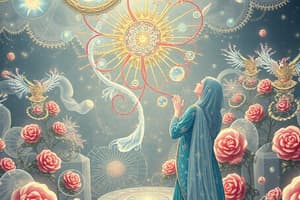Podcast
Questions and Answers
What is the process called when particles mix and spread by colliding with each other in liquids and gases?
What is the process called when particles mix and spread by colliding with each other in liquids and gases?
- Convection
- Diffusion (correct)
- Conduction
- Vaporization
During diffusion, particles move from areas of ______ concentration to areas of ______ concentration.
During diffusion, particles move from areas of ______ concentration to areas of ______ concentration.
- Random; uniform
- High; low (correct)
- Equal; high
- Low; high
What happens to the potassium manganate(VII) when it is placed in water?
What happens to the potassium manganate(VII) when it is placed in water?
- It evaporates quickly.
- It dissolves and its color spreads. (correct)
- It sinks to the bottom.
- It reacts with the water.
Which statement about the behavior of particles during phase changes is correct?
Which statement about the behavior of particles during phase changes is correct?
When bromine vapour is placed in an upside-down jar, how does the color spread?
When bromine vapour is placed in an upside-down jar, how does the color spread?
What are the smallest indivisible particles that constitute matter called?
What are the smallest indivisible particles that constitute matter called?
In the cooling curve of water, what occurs as the temperature decreases?
In the cooling curve of water, what occurs as the temperature decreases?
What effect does increasing temperature typically have on the kinetic energy of particles?
What effect does increasing temperature typically have on the kinetic energy of particles?
What happens to the particles in a solid when it is heated?
What happens to the particles in a solid when it is heated?
Which characteristic distinguishes a gas from liquids and solids?
Which characteristic distinguishes a gas from liquids and solids?
Why does a solid change to a liquid upon heating?
Why does a solid change to a liquid upon heating?
How does the relationship between temperature and heat energy impact phase changes?
How does the relationship between temperature and heat energy impact phase changes?
What occurs during the cooling phase of a substance?
What occurs during the cooling phase of a substance?
What characterizes the behavior of particles in a solid?
What characterizes the behavior of particles in a solid?
What occurs during the melting phase of water?
What occurs during the melting phase of water?
How does temperature affect the state of water during heating?
How does temperature affect the state of water during heating?
Which of the following accurately describes the motion of gas particles?
Which of the following accurately describes the motion of gas particles?
What causes bromine vapor to spread upwards in air despite being heavier than air?
What causes bromine vapor to spread upwards in air despite being heavier than air?
What is an ion?
What is an ion?
What distinguishes a molecule from a single atom?
What distinguishes a molecule from a single atom?
During the cooling phase of water, what happens to the particles?
During the cooling phase of water, what happens to the particles?
Flashcards are hidden until you start studying
Study Notes
States of Matter
- Diffusion is the process where particles mix and spread by colliding with other particles and bouncing off in all directions.
- Diffusion takes place in liquids and gases.
- Particles spread from where they are more concentrated until they are evenly mixed.
- Atoms are the smallest particles that cannot be broken down further in chemical reactions.
- Molecules are particles that consist of two or more atoms joined together.
- Ions are atoms or groups of atoms that carry a charge.
- Solid particles are arranged in a regular pattern or lattice and held together by strong forces. They can only vibrate to and fro.
- Liquid particles can move about and slide past each other. They are close together but not in a lattice. The forces that hold them together are weaker than in a solid.
- Gas particles are far apart and move about very quickly. They collide with each other and bounce off in all directions.
- When a solid is heated, its particles gain energy and vibrate more, causing the solid to expand.
- At the melting point, particles vibrate so much that they break away from their positions and the solid turns into a liquid.
- Electron microscopes can be used to see images of atoms.
- A solid has a fixed shape and volume, does not flow, and cannot be compressed.
- A liquid flows easily, has a fixed volume, but changes shape to fit its container.
- A gas does not have a fixed volume or shape, spreads out to fill its container, and is lighter than the same volume of solid or liquid.
- Water can exist in three states: solid (ice), liquid (water), and gas (steam).
Seeing Atoms
- Atoms cannot be seen through light microscopes, but images can be taken using electron microscopes.
Diffusion
- Diffusion is the process where particles spread out from areas of high concentration to areas of low concentration.
- The smell of perfume travels across a room due to the diffusion of perfume particles in the air.
Particles
- The three types of particles in chemistry are atoms, molecules, and ions.
- An atom is the smallest unit of an element.
- A molecule is formed when two or more atoms bond together.
- An ion is an atom that has gained or lost electrons, giving it a positive or negative charge.
Studying That Suits You
Use AI to generate personalized quizzes and flashcards to suit your learning preferences.




